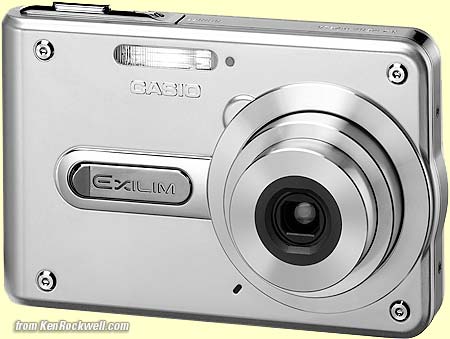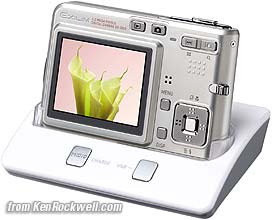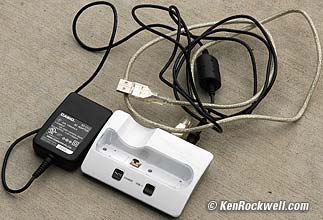Home Search Gallery How-To Books Links Workshops About Contact
|
POWER, CRADLE and BATTERIES back to first page and index Power The battery is charged by putting the camera in a cradle and the cradle then requires a separate AC adaptor. The AC adaptor (AD-C51J) is a tiny switching supply with an integral folding plug. It runs on all power worldwide from 100 - 240 VAC and 50 - 60 Hz. This is good, but also means you have to pack the cradle and AC adaptor with you for travel. I'd suggest the stand-alone charger and an SD card reader for travel. Depending on where you buy it you might get a charger with the AC cord (AD-C51G) instead of the US AD-C51J model with the folding plug. I wish that the cradle could power itself from my laptop's USB connection to save having to carry the AC adaptor. Cradle back to top of power page back to top of review The EX-S100 comes with a cradle which is both a charging stand and a card reader. This cradle is powered by the included AC adapter. Just pop the camera into the cradle and you're both charging and reading data as you like. You can get a replacement CA-25 Cradle and AC Adaptor here for about $50 if you lose it.
For travel you also need to remember to take the AC adaptor and USB cable. I weighed the CA-25 cradle at 2 -1/4 oz (60 g) and measured it at 4" x 2.6" x 1" (101 x 66 x 25mm). I weighed the AD-C51J AC adapter and cord combined at 3 oz. (90 g), which was mostly the cord. I weighed the AC adapter itself at 1.5 oz (45 g). I measured it at 2.7 x 1.8 x 0.6." (68 x 47 x 15 mm). The adapter, at least in the USA, is a super slim switching supply with a plug that folds into its body. It's rated 100 - 240 V, 50/60 Hz, meaning it will work with electricity anywhere with just mechanical plug adaptors. The cradle is an excellent idea for normal people who work in a fixed location like my mom. Go out, make photos all day, drop in the camera at night, transfer your photos and charge the battery. EASY! For travel I'd prefer a single cable connected directly to the camera, powered by my laptop computer through the USB bus, to do the same thing without needing the AC adaptor or cradle. The cradle has two buttons: "PHOTO" and "USB." Press the PHOTO button for a cute little slide show on the camera screen as it sits in the cradle. Press the USB button to start or end the connection to your computer. There's a USB light. It's solid green when connected and flashing green when transferring data. Otherwise it's off. It lights up behind the "USB" marking. Be sure to hit the eject button next to the camera's icon in your Mac's Finder before hitting the USB button to disconnect, since it might make some computers unhappy otherwise. In windows you should find and use both the eject command and then the remove hardware commands, good luck (that's why I use Mac). By default the camera charges when put in the stand. You have to hit the USB button to connect to your computer. It stops charging when you do this, so be sure to disconnect the USB connection by hitting the USB button again to charge the battery after transferring data. There's also a charging light. Red is charging, green is complete. Off is no charging. Amber means that the camera is too hot or cold to charge, so wait until the temperature returns to normal for charging. Casio calls this amber mode "charge standby" in the manual. If you get a flashing red that means something's wrong; remove the camera and try again. The cradle starts the charge cycle whenever you remove the camera and put it back. Of course the charging cycle is much shorter if the battery is full. Unfortunately it's not smart enough to know if it just completely charged the battery, so even if you change functions or remove it for just a moment it jams charging current into the battery until it figures out that it's full. The cradle effectively is an AC adaptor, however few camera functions operate while in the cradle. Good news is that for USB data transfer to my Apple iBook Mac laptop I don't need the AC adaptor; it transfers data powered just by the computer. Bad news is one needs to plug the AC Adaptor into a wall to charge the battery. It won't charge from the computer's power. Battery back to top of power page back to top of review Tiny NP-20 3.7V 680 mAh Battery The tiny NP-20 Lithium ion rechargeable battery only weighs half an ounce or 16 g. Casio rates it for 180 shots with flash 50% of the time (CIPA) and 540 shots without. I got 271 shots when the battery meter dropped to 2/3, 308 shots at 1/3 and 343 when it died. These were without a lot of flash but were with many long exposures. You can get another one here or here for about $30. Avoid the off brands and stick with the Casio branded battery; I see little price advantage for gambling with off brands. For travel you can get a stand-alone BC-10L battery charger here for about $40. The battery meter is excellent and gives plenty of warning. It has four levels indicated as the usual bar inside a battery. It's also color coded: Full is cyan, half full is yellow, almost empty and empty are red. The book says it takes two hours and twenty minutes to charge fully, and lo and behold that's exactly what a dead one took to charge. With a partially charged battery it's quicker: after 50 - 100 shots it takes 30 minutes to an hour to charge. It's easy to insert the battery upside down, in which case the S100 simply doesn't work. Not to worry, just put it back in the correct way. Li-ion batteries love being recharged as soon as you can and they last longer that way. It's better to charge partially discharged batteries than to run them all the way down as with nickel based systems. More on batteries here. Backup Battery I pulled the battery out for 13 hours and the clock and all the settings were fine. Page 207 of the manual says the camera has no backup for the clock and page 45 says it has a two day backup. I'd believe page 45. This is only important if you remove the battery to charge it in an optional external charger. Next Page: Lens Performance, Image Settings and Quality |




